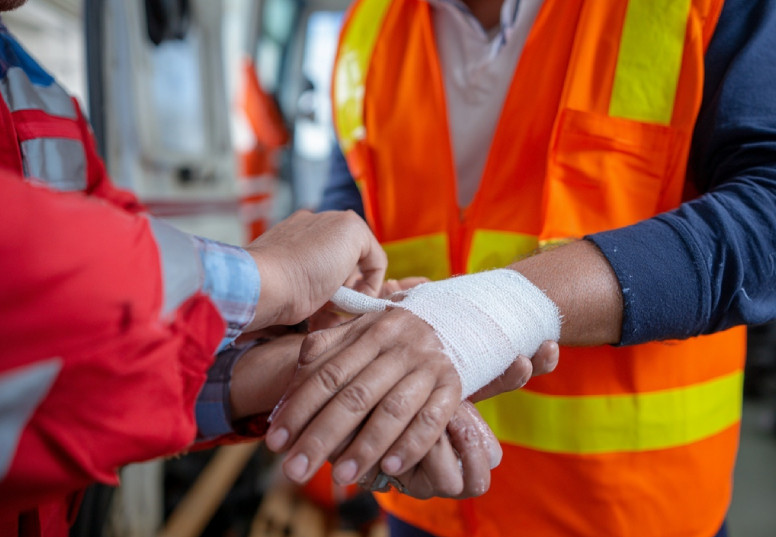No one ever really expects an accident to happen at work, but when it does, it can throw everything off balance. You’re dealing with a person who might be in pain or shaken up, plus there’s the sudden pressure to respond properly, sort out paperwork, and still keep the business ticking along. It’s a lot to handle, especially if you’ve never had to go through it before.
This guide is for small to mid-sized business owners and managers who’ve got a lot on their plate already. We’re walking through what to do when one of your employees is injured on the job, how to support them, and how to cover yourself legally. It’s not about ticking boxes or quoting laws you’ll forget in a week. It’s about being human, staying calm, and knowing what actually matters when things go sideways.
Immediate Steps After the Incident
The first few minutes after an accident can be a bit of a blur. But your job is to make sure no one else gets hurt and the injured worker gets the care they need.
Start by checking if emergency help is needed. If it’s serious, don’t muck around, call an ambulance. If it’s minor, make sure someone trained in first aid is helping. Once they’re being looked after, think about whether the area needs to be shut down or roped off. You don’t want another person tripping over the same hazard or getting too close to machinery.
You also need to start keeping track of what happened. That includes noting the time, location, what the employee was doing, and any other people nearby. Photos can help too if it’s something physical like a spill or broken equipment. It doesn’t have to be fancy. A few snaps on your phone and a few notes scribbled down can go a long way.
While this is all happening, let your team know what’s going on. If others witnessed it, ask them to stay nearby so they can give a statement later. You don’t need a full investigation in the moment, but people tend to forget details quickly, so it helps to get their version while it’s still fresh.
Reporting the Incident
Once the dust settles a bit, it’s time to start the official process. In most states across Australia, you’re required to report workplace injuries within a specific timeframe. Don’t leave it till the end of the week. You should be notifying your workers’ compensation insurer the same day if you can, or the day after at the latest.
Write up an incident report that covers what happened, who was involved, and any injuries sustained. If there were any witnesses, get their statements and contact details. Keep all of this in a safe spot, because it’ll be needed if there’s a claim or investigation later.
Some incidents also need to be reported to WorkSafe (or the relevant safety authority in your state). This includes serious injuries like amputations, fractures, or anything that required immediate hospital treatment. Failing to notify them can lead to some pretty hefty fines. So if you’re unsure, play it safe and give them a call.

Supporting the Injured Employee
It’s easy to get bogged down in red tape and forget there’s a real person behind all this. They might be sore, embarrassed, or worried about losing income. So keep communication open and human.
Let them know you’re there to help and explain what happens next. If they’re eligible for workers’ compensation, walk them through how to lodge the claim. Some folks have never dealt with this stuff before and it can feel a bit overwhelming.
If they need medical care or rehab, support them in getting it sorted. You don’t have to be their personal assistant, but a quick check-in or offer to help book an appointment can go a long way. The way you treat them now can also shape how they feel about returning to work.
When they’re ready to come back, be flexible. That might mean reduced hours, light duties, or a phased return. Keep talking with them and make sure they’re not rushing back before they’re ready. A proper return-to-work plan isn’t just good for morale, it’s part of your legal responsibility.
Understanding Legal Obligations
As an employer, you have pretty clear responsibilities under Australia’s work health and safety laws. It’s your job to provide a safe workplace, report accidents properly, and back your staff through their recovery. These aren’t just tick-box chores — missing deadlines for lodging claims or paperwork can cause real trouble. It’s not only fines you’re risking, but also potential legal battles or losing insurance cover. Even smaller incidents need your attention.
Take for example a delivery driver who’s involved in a traffic accident while out on a job. Say they’re driving between sites and another car runs a red light, hitting them. This counts as a work-related injury, so you need to report it as you would any workplace accident. That means getting the right paperwork in, notifying your workers’ comp insurer, and supporting the employee through medical checks and treatment. If you don’t handle this correctly, you could end up with costly claims delays or legal issues, especially if liability gets complicated by the other driver’s fault.

We’ve talked with the guys at Podmore Legal about this https://podmorelegal.com/traffic-offence-lawyers-perth/, and their advice is simple: get on the front foot. If you’re unsure about what to do, pick up the phone and ask a lawyer who really knows the ins and outs. It beats waiting for a letter from a regulator or court further down the line.
It also pays to have clear internal policies around reporting injuries, managing modified duties, and workplace safety. That way, your staff aren’t left guessing, and you’ve got a plan ready when things go pear-shaped. Being prepared is better than scrambling when the worst happens.
What If It Was a Traffic Accident During Work?
Now here’s one that catches a lot of people off guard. Say your employee is driving between job sites, doing deliveries, or picking something up for work, and they get into a car accident. That’s still considered a work-related injury in most cases.
It doesn’t matter if they were in their own car or a company vehicle. As long as they were doing something connected to their job at the time, workers’ compensation should still apply.
In these situations, you’ll need a bit more documentation. A police report is key, especially if another driver was involved. If there’s dashcam footage, save a copy. The employee should also be checked over by a doctor, even if the injuries seem minor at first. Car accidents can cause things like whiplash or concussions that take a while to show up.
CTP (Compulsory Third Party) insurance comes into play too. If someone else was at fault, there might be a separate claim there as well. But that doesn’t change your obligation to support your employee and get the workers’ comp process rolling.
Also be aware that a traffic accident at work still needs to be reported internally and possibly to your work health authority, depending on the injury. Don’t assume your insurer will figure it all out for you.

Review and Prevent Future Incidents
Once the immediate stuff is sorted, take a step back and look at what actually caused the accident. Was it a dodgy bit of equipment? A task that’s always been a bit risky? A lack of training? Even if it seems like a freak accident, there’s usually something that could’ve been done differently.
Bring your team in on this too. They’re the ones doing the work every day, so they’ll often have ideas on how to make things safer or easier. It might mean updating a policy, replacing worn-out gear, or even just reminding people about safety procedures.
Also, don’t underestimate the power of simple reminders and check-ins. A quick refresher training or a chat in a toolbox meeting can make a real difference. It’s not about laying blame or ticking boxes, but keeping people thinking about how they work and where the risks are hiding.
Wrapping Things Up
Workplace injuries are never easy, but how you respond can make a world of difference. Your goal isn’t to become an expert overnight, but to act with care, stay organised, and keep people safe. If you’ve got the right systems in place and you’re not afraid to ask for help when you need it, you’re already ahead of the game.
And remember, your response sends a message to the rest of the team too. If you handle things well, they’ll know you’ve got their backs. That’s worth a lot more than just ticking off legal boxes.
